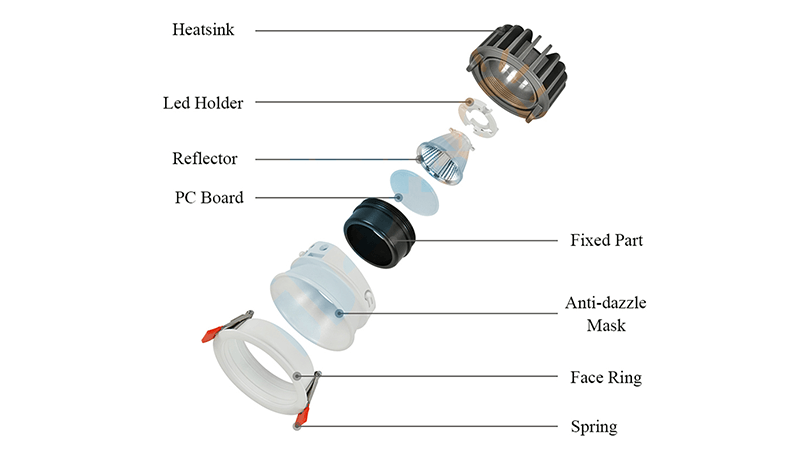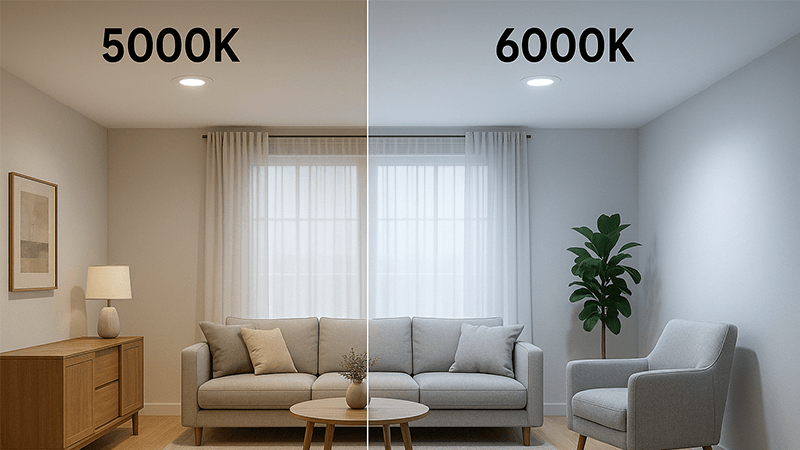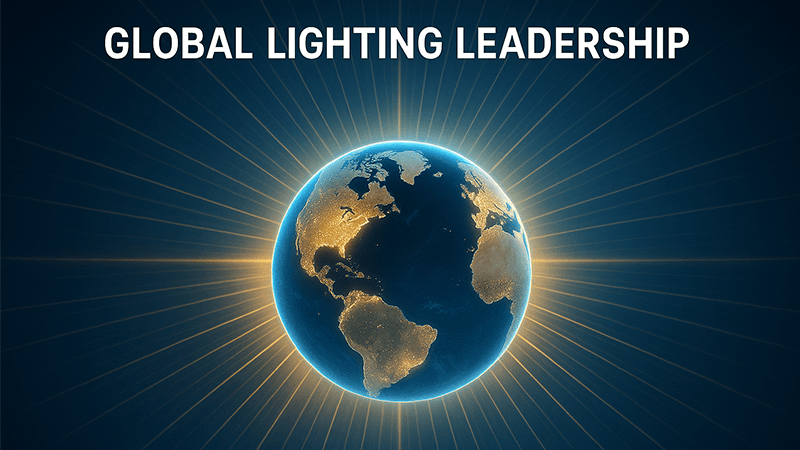Finding the right LED downlight feels impossible. You worry that a wrong choice will lead to project delays and unhappy clients. The "best" downlight is not a brand name, but the one perfectly tailored to your project.
The best LED downlight manufacturer is not about a single brand. It’s about finding a partner who provides the right mix of quality components, customization options, proven reliability, and dedicated support that aligns perfectly with your specific project needs and budget.

I’ve spent my entire career in the LED lighting industry. I started on the factory floor and eventually built my own manufacturing business. Over the years, I’ve seen countless purchasing managers like you struggle with this exact question. They search for a simple answer, a single "best" brand. But the truth is more complex and, honestly, more interesting. The real secret isn’t in finding the top-ranked company, but in understanding what makes a downlight truly great for your specific needs. Let’s break down what you should really be looking for.
What is the best quality LED light brand?
You’re under pressure to find top-quality brands that guarantee project success. But big brand names often carry a big price tag, without ensuring they’re the right fit. Quality is about the components, not just the brand sticker.
Brands like Philips (Signify) and Osram are known for quality. However, the "best" quality for your project comes from a supplier transparent about their components. This includes the LED chips, drivers, and heat sinks, which truly determine reliability and performance for your application.

When we talk about "quality," it’s easy to think of the famous brand names. And yes, those companies built their reputations for a reason. But as a purchasing manager, you know that true quality lies in the details—the parts that make up the whole. For a product like an LED downlight, this is especially true. The brand on the box is less important than the technology inside it. I always tell my partners to look past the marketing and ask hard questions about the components. This is where you can truly evaluate if you’re getting value.
The Anatomy of a Quality Downlight
A downlight is a system of parts working together. The quality of each part directly impacts the final performance, lifespan, and safety of the light. Here are the core components you must scrutinize:
- LED Chips: This is the light source itself. Brands like Cree, Bridgelux, or Samsung are marks of quality, but the key metrics are efficacy (lumens per watt), color rendering index (CRI), and color consistency (SDCM). For high-end commercial spaces, you need a CRI above 90 and an SDCM below 3 to ensure colors look natural and all fixtures match perfectly.
- LED Driver: This is the power supply, and it’s often the first part to fail. A quality driver from a brand like Tridonic, BOKE, or Eaglerise will be flicker-free, have a high power factor (>0.9), and offer protection against surges and overheating. It’s the heart of the downlight, and skimping here leads to callbacks and replacements.
- Heat Sink: LEDs generate heat, and managing that heat is critical for a long lifespan. A well-designed heat sink, usually made of die-cast or cold-forged aluminum, will efficiently pull heat away from the LED chip. Poor thermal management is a silent killer of LED products.
| Component |
High-Quality Indicators |
Why It Matters for Your Projects |
| LED Chip |
CRI >90, R9 >50, Efficacy >100 lm/W, SDCM <3 |
Ensures true color representation, vibrant visuals, and fixture-to-fixture consistency, which is critical for retail and hospitality. |
| LED Driver |
Flicker-Free, PF >0.9, 5-Year Warranty |
Prevents occupant headaches and eye strain. Guarantees electrical efficiency and long-term reliability, reducing maintenance costs. |
| Heat Sink |
Cold-Forged or Die-Cast Aluminum |
Provides superior thermal management, ensuring the LED chip operates at a safe temperature for a long and stable life (>50,000 hours). |
| Optics |
Low UGR (<19), High-Transmittance Lens |
Delivers comfortable, non-glare lighting that enhances the space. Maximizes light output and directs it exactly where needed. |
I remember working with a client on a luxury hotel project in Dubai. He was insisting on using a famous European brand. We looked at their specs and then I showed him one of our ODM downlights. We used the same Cree LED chips, the same Tridonic driver, and our thermal management was even better. The result? We delivered a product with identical performance and a 7-year warranty, saving him nearly 30% on his budget. That’s the power of looking beyond the brand.
Which company is best in LED lights?
You need more than just a product; you need a reliable company for a long-term partnership. Choosing the wrong one can cause supply chain nightmares, inconsistent quality, and zero support when you need it most. The best company is a partner who truly understands your business.
The "best" company depends on your needs. For retail, Philips or Osram are strong. For large-scale projects, a flexible OEM/ODM manufacturer like us at iPHD (Upward Lighting) might be better. We offer the customization, direct communication, and value that big brands cannot match.

Choosing a company to partner with is like choosing a team member. You need someone who is reliable, communicates well, and has the skills to get the job done right. The biggest lighting corporations in the world are great, but they operate like giant machines. Sometimes, what you need is a specialized workshop, not a massive factory. Your role as a purchasing manager requires you to build relationships with suppliers who can adapt and respond to your unique challenges.
Global Brand vs. OEM/ODM Partner
The debate between a global brand and a specialized OEM/ODM manufacturer is about more than just price. It’s about access, flexibility, and control. Understanding the differences helps you decide which "team member" is right for your project.
- Global Brands (e.g., Signify, Osram): These companies offer a strong brand reputation, extensive R&D, and a wide, standardized product catalog. They are a safe bet. However, they are often rigid. Customization is difficult and expensive, communication goes through many layers of sales and distribution, and their pricing includes significant marketing and overhead costs.
- OEM/ODM Partners (e.g., iPHD): A good OEM/ODM partner is your factory. We offer direct access to engineers and the production line. Need a specific color temperature, a unique beam angle, or a housing painted to match a ceiling? We can do that. Our pricing is more direct because you aren’t paying for global marketing campaigns. The key is finding a reputable partner with proven quality control and a history of success.
I once had a distributor from the UAE, much like you, who was struggling with a big brand. His client needed an anti-glare downlight with a specific 24-degree beam angle and a gold-colored reflector for a chain of boutique stores. The big brand said no—it wasn’t in their catalog. He came to us. My engineers and I worked with him, created a prototype in two weeks, and had the full order ready in 45 days. He became the hero for his client. That’s the kind of partnership that builds businesses.
| Factor |
Global Brand (Philips, Osram) |
OEM/ODM Partner (iPHD) |
The Best Choice For… |
| Customization |
Very limited; high MOQs |
Highly flexible; lower MOQs |
OEM/ODM for unique project requirements. |
| Price |
Higher (brand premium) |
More competitive (direct from factory) |
OEM/ODM for budget-conscious projects without sacrificing quality. |
| Communication |
Indirect (through distributors) |
Direct (with engineers & sales) |
OEM/ODM for faster problem-solving and collaboration. |
| Innovation |
Slower, more standardized |
Faster, more agile |
OEM/ODM for getting the latest tech into your projects quickly. |
| Brand Recognition |
High |
Low (Your brand on the product) |
Global Brand when the end client demands a specific famous name. |
Ultimately, the "best" company is the one that makes you look good. It’s the one that delivers on its promises, helps you solve problems, and gives you a competitive edge.
Is 5000K or 6000K brighter?
You’re trying to select the right color temperature for a space. Choosing the wrong one can make a room feel sterile or dingy, but you’re not sure if 5000K or 6000K is actually brighter. It’s a common point of confusion that can impact the whole feel of a project.
Technically, 5000K and 6000K are not measures of brightness (lumens), but color temperature. However, the human eye perceives the cooler, bluer light of 6000K as brighter or more intense than the neutral white light of 5000K, even at the same lumen output.

This is one of the most frequent questions I get, and it highlights a common misunderstanding between technical specs and human perception. Brightness is measured in lumens. Color temperature, measured in Kelvin (K), describes the color appearance of the light. But the two are linked in how we experience a lit environment. As a purchasing expert, knowing this distinction is key to guiding your clients to the right choice, not just for brightness, but for the desired atmosphere.
Choosing the Right Kelvin for the Right Space
The difference between 5000K and 6000K might seem small on paper, but in a real-world application, it can dramatically change the mood and functionality of a space. It’s not about which one is "better," but which one is appropriate.
- 5000K (Neutral/Cool White): This color temperature is very close to natural daylight. It renders colors accurately and provides a clean, crisp, and alert feel without being harsh. It’s an excellent choice for environments where focus and clarity are important. Think of it as the bright light of a clear midday sun.
- 6000K (Cool/Blue White): This light has a noticeable blue tint. It feels very bright, almost clinical, and is highly stimulating. While our eyes perceive it as brighter, this intense blueish light can feel sterile and unwelcoming in many settings. It is often called "daylight," but it’s more like the light of an overcast sky.
Let’s put this into the context of projects you might be sourcing for:
| Application |
Recommended Kelvin |
Why It Works |
| Office Spaces |
4000K – 5000K |
Promotes alertness and focus without the harsh, clinical feel of 6000K. 5000K is great for task areas. |
| Retail Stores |
3000K – 4000K |
Warmer tones create a more welcoming and comfortable shopping experience. 5000K can be used for high-end jewelry to add sparkle. |
| Warehouses/Factories |
5000K |
Provides excellent visibility and safety for task-oriented environments. Clarity is more important than atmosphere. |
| Hospitals/Clinics |
5000K – 6000K |
5000K is good for general areas. The very crisp, clean feel of 6000K is often used in examination rooms where maximum visual acuity is needed. |
| Outdoor/Parking |
5000K |
Offers great visibility for security purposes without the stark blue tint of 6000K, which can feel unnatural. |
I always advise clients to consider the human element. For a project in the UAE, where the sun is intense, using 6000K indoors can feel cold and unpleasant. A 5000K light provides that feeling of bright daylight but remains more balanced and comfortable for indoor use. The perception of brightness from 6000K is real, but it often comes at the cost of comfort.
What is the world’s number one lighting brand?
You want to align with the industry leader. Knowing who is at the top gives you a benchmark for quality and innovation. But a single "number one" title can be misleading and may not serve your specific needs as a purchasing manager.
By revenue and market share, Signify (formerly Philips Lighting) is generally considered the world’s number one lighting brand. However, this ranking doesn’t automatically make them the "best" choice for every single project, especially when customization, service, and value are critical.

It’s natural to look at rankings. We all want to know who is leading the pack. Signify’s position as number one is a testament to their long history, innovation in connected lighting, and massive global reach. They have an incredible portfolio of products and a powerful brand. But I’ve learned that leadership in the lighting industry isn’t just about being the biggest. As I’ve said from the beginning, the true goal is to find the perfect light for the job. Sometimes the biggest player isn’t the one who can help you do that.
Looking Beyond the Number One Spot
The title of "number one" is based on metrics like sales revenue and market volume. It doesn’t always reflect other factors that are incredibly important to a purchasing manager like you, or to an installer or end user. There are different ways to define leadership.
- Leadership in Innovation: Companies like Cree lead in the development of high-performance LED chips. Brands like Tridonic or BOKE lead in driver technology. These are the innovators whose components are used by hundreds of other manufacturers, including the big brands. Partnering with a manufacturer who integrates the latest from these innovators can give you a more advanced product.
- Leadership in a Niche: Some companies are leaders in specific areas. For example, a company might be the world’s best at architectural lighting for museums, or another might dominate in explosion-proof lighting for industrial sites. Their specialization makes them the "number one" for that specific application.
- Leadership in Partnership: This is where I believe companies like mine, iPHD, can truly be number one for our clients. We lead by being the best partner. We offer flexibility, direct communication, and a commitment to helping our clients succeed. The biggest brand in the world can’t offer you a direct line to the owner or the head engineer to solve a problem on a weekend. A dedicated partner can.
The key takeaway is that you should use the "number one" brand as a benchmark for quality and performance. Study their products. Understand their specifications. Then, take that knowledge and challenge your other potential suppliers. Ask them: "Can you meet or exceed these specs? Can you do it with more flexibility and at a better value?" The best suppliers will welcome this challenge. They will be transparent about their capabilities and show you how they can provide a solution that is perfect for you, not just one that comes from a catalog. The world’s number one lighting brand is a great reference point, but your number one partner is the one who helps your business grow.
Conclusion
The "best" LED downlight is not a single brand. It’s a solution that balances quality, performance, and cost, perfectly matching your project. The best manufacturer is a partner who delivers this solution.